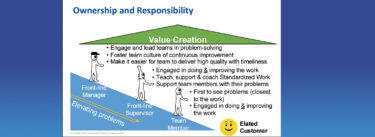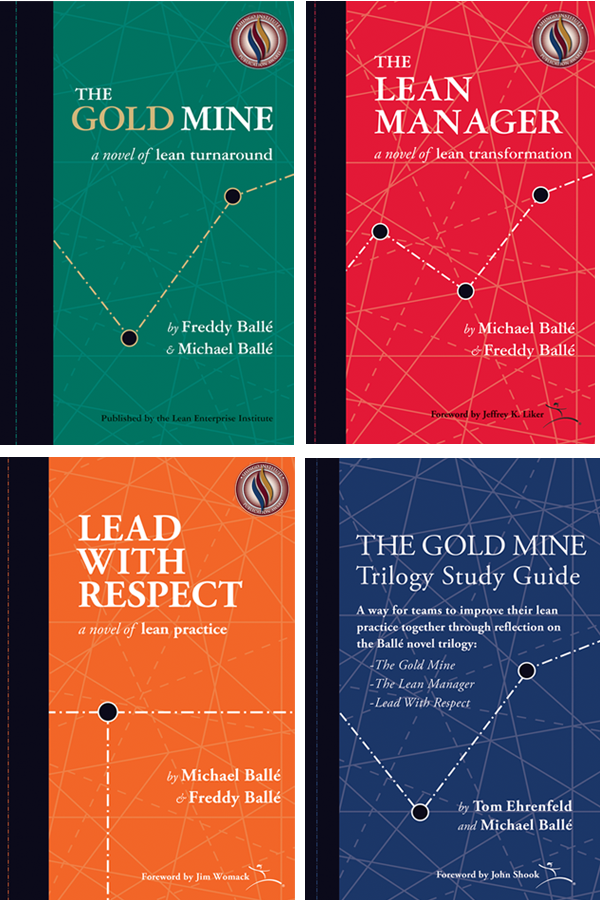I’ve been thinking about the challenge of lean transformation for 27 years now, since I started studying Toyota as part of the MIT global automotive project in 1979. That’s a long time and during this period I’ve watched lean thinking progress through a series of stages.
In the early years much of the focus was on sorting out what was specific to a culture. Could anyone outside of Japan embrace lean thinking? Could anyone outside of Toyota? And there was much confusion about the elements of a lean business system. Was it just in the factory? Or did it apply to every aspect of an organization, including product development, supply chain management, customer relations, and general management? In The Machine That Changed the World in 1990, Dan Jones, Dan Roos and I made an effective case that lean thinking can be applied by any company any where in the world but that the full power of the system is only realized when it is applied to all elements of the enterprise.
As this view became accepted, the focus turned to how organizations everywhere could transform themselves from mass producers into lean exemplars. Given the magnitude of the task and its many dimensions it’s understandable that lean tools came to the foreground: 5S, setup reduction, the five whys, target costing, simultaneous and concurrent engineering, value-stream maps, kanban, kaizen. Indeed, I think of the period from the early 1990s up to the present as the Tool Age of the lean movement.
The attraction of tools is that they can be employed at many points within an organization, often by staff improvement teams or external consultants. Even better, they can be applied in isolation without tackling the difficult task of changing the organization and the fundamental approach to management. I often say that managers will try anything easy that doesn’t work before they will try anything hard that does, and this may be a fair summary of what happened in the Tool Age
In the past 15 years, we all learned about a lot of lean tools. We also learned how to apply them and we had some modest success. But we are yet to come close to creating a second Toyota, much less a third, fourth or fifth! By contrast, the previously dominant mass production approach to management – as perfected by Alfred Sloan at General Motors in the 1920s – was widely and successfully copied within a short period of demonstrating its superiority.
Fortunately, I now see signs that the lean movement is finally tackling the fundamental issues of lean management. I’ve recently had a number of conversations in a number of countries – the US, Germany, China – with senior managers who realize that they need to think more about lean management before thinking further about lean tools.
What do I mean by “lean management”? Let me start with some general observations about organization and management:
- All value created in any organization is the end result of a lengthy sequence of steps – a value stream. These steps must be conducted properly in the proper sequence at the proper time.
- Getting the right value to the customer at the right time with the right cost to the organization is the key to survival and prosperity.
- The flow of value toward the customer is horizontal, across the organization.
- All organizations – including Toyota – are organized vertically by department (engineering, purchasing, production, sales, etc.) They always will be because this is the best way to create and store knowledge and the most practical way to channel careers.
- Someone needs to see, manage, and improve the entire process of horizontal value creation on behalf of the customer, from concept to launch, from order through production to delivery, and from delivery through the product life cycle.
- In most organizations no one is actually responsible for the horizontal flow of value by product family, whatever senior managers may think. The product is an organizational orphan.
- In most organizations managers at every level are being graded on whether they make their department-specific numbers. These are the metrics – usually financial – set by high-level managers as they attempt to fully utilize assets and “control” the organization.
- Improvements to value streams are managed by staff experts (or consultants) who usually don’t see the whole flow of value, the most pressing needs of the customer, and the most urgent business needs of the organization. They use the tools they feel most comfortable with to solve the problems that seem easiest.
How can “lean management” help? Here are three simple elements of lean management worthy of experimentation:
- Make sure every value stream has someone responsible for overseeing the whole flow of value and continually improving every aspect of the process in light of the needs of the customer and the business.
The question for this value-stream manager to ask is, “How can I make customers happy while making money by engaging the full energies of our people to improve this value stream?”
Note that the value-stream manager doesn’t need a large staff or authority over employees touching the value stream. Instead, the value-stream manager needs to negotiate with the department heads about the needs of the product and resolve any differences by appeal to the most senior managers.
Similarly, no employee should have more than one boss. A good system of value-stream management gives every lower-level employee a boss in his or her department who has determined in conversation with the value-stream manager what that department needs to do to support the value stream. This avoids complex matrices in which employees have two (or more) bosses.
- Instead of developing complex metrics, ask value-stream managers how they will improve the value- creating process they are overseeing.
If managers focus on their process, the performance metrics will come right; but if managers focus on their numbers, the process is likely never to improve. And note that most metrics are nothing more than end-of-the-line quality inspection: At the end of the quarter or the end of the year everyone looks to see what happened, at a point long after the mistakes have been made.
- Teach all managers to ask questions about their value streams (rather than giving answers and orders from higher levels.) Turn these questions into experiments using Plan-Do-Check-Act.
Only management by science through constant experimentation to answer questions can produce sustainable improvements in value streams. (Toyota’s A3 is a wonderful management tool for putting science to work and I’ll have more to say about it in the next few months.)
Please understand: Lean tools are great. We all need to master and deploy them, and our efforts of the last 15 years to do so are not wasted. But just as a carpenter needs a vision of what to build in order to get the full benefit of a hammer, we need a clear vision of our organizational objectives and better management methods before we pick up our lean tools.
Lean management is the key to doing this. We don’t yet know all the elements but discovering and deploying them is the challenge we all need to tackle in the next stage of the lean movement.
Best regards,
Jim
Jim Womack
Founder and Chairman
Lean Enterprise Institute (LEI)






